This is a Veteran Owned site
Definitions / Glossary
The following are basic definitions for commonly-used woodworking terms and words.
Do you have a term that should be added to this list? – Email Me!
A
Aliphatic Resin – The base component of the most popular woodworking glues, often called yellow glue. In recent years, new versions of this glue have been developed with varying "open" or "set" times that allow more time between application and the glue beginning to harden. (See "Open Time")
Alternate Top Bevel (ATB) – Describes a common tooth pattern on many round saw blades. Generally, one tooth is beveled to the right, one to the left and another ground straight. These tooth designs may be arranged in various orders and numbers but the purpose is the same. The angled teeth slice the wood fibers along the edges and the flat tooth cleans the cut up.
B
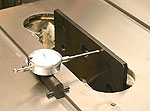 Blade Parallelism – The key table saw alignment, getting the blade parallel to the miter slot is crucial to the performance of the saw, blade and to safety. In fact, because the miter slot is the one constant, non-adjustable feature on the table saw, all alignments are related to it. The blade, rip fence should be parallel to the miter slot while the miter gauge (also called a miter guide) should all be square to the miter slot.
Blade Parallelism – The key table saw alignment, getting the blade parallel to the miter slot is crucial to the performance of the saw, blade and to safety. In fact, because the miter slot is the one constant, non-adjustable feature on the table saw, all alignments are related to it. The blade, rip fence should be parallel to the miter slot while the miter gauge (also called a miter guide) should all be square to the miter slot.
Box Joint – A series of interlocking square cuts often used to join the ends of boards when making boxes. The interlocking cuts (sometimes called fingers) expose considerable amounts of long grain while also increasing the amount of glue surface. This is a very strong type of joint that can be attractive as well when finish materials highlight the end grain against the long grain on both faces of the joint. Common tools used to make Box Joints are flat-bottomed router bits, stacked dado blades and a jig that creates the spacing needed for the interlocking cuts to fit properly. See Building a Box Joint Jig in the Tips & Tricks section.
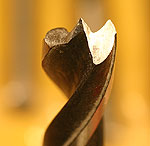 Brad Point Bit – A specialized drill design for cutting clean holes in all types of wood. The most prominent feature is a spear-like point that helps keep the drill on a layout mark and prevent it from wandering as the hole is started and as the bit encounters grain lines. Some brad point bits also have extended cutters at the outer edges that slice the grain for a cleaner edge. Brad point bits are available in most common drill sizes though finding this design over 1" in diameter is difficult.
Brad Point Bit – A specialized drill design for cutting clean holes in all types of wood. The most prominent feature is a spear-like point that helps keep the drill on a layout mark and prevent it from wandering as the hole is started and as the bit encounters grain lines. Some brad point bits also have extended cutters at the outer edges that slice the grain for a cleaner edge. Brad point bits are available in most common drill sizes though finding this design over 1" in diameter is difficult.
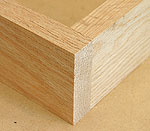 Butt Joint – Joining the end of one board, usually to the wide face of another with no other features such as a rabbet. Though very simple, the butt joint is also very weak because it is the classic short grain to long grain situation that affords adhesives very little to grip. Butt joints are often reinforced with some form of mechanical fastener such as screws, biscuits or dowels.
Butt Joint – Joining the end of one board, usually to the wide face of another with no other features such as a rabbet. Though very simple, the butt joint is also very weak because it is the classic short grain to long grain situation that affords adhesives very little to grip. Butt joints are often reinforced with some form of mechanical fastener such as screws, biscuits or dowels.
D
Dado – A flat-bottomed groove used to connect one piece of wood to another. A common use is installing shelves into the vertical sides of a cabinet. Dados are sized to closely fit the wood that will be set into them. The depth of a dado is generally one third of the thickness of the wood it is cut into though many woodworkers vary this to some degree. The most common tools used to cut dados are flat-bottomed router bits (special sizes are available to fit common plywood thicknesses) and stacked dado cutters. See a story on making dados.
E
End Grain – See Short Grain
F
Featherboard – Used to maintain pressure against a work piece to maintain its contact with a fence, featherboards are available commercially but are often made in the shop. The most common configuration is a row of fingers (about 1/8"-wide normally) cut into the end of a board cut at approximately 30-degrees. The angle of the fingers allows the work piece to slip by easily but prevents it from backing up, making the featherboard reasonably effective at preventing kickbacks. See a Plan for making Featherboards.
Feed Direction – In order to maintain control, wood must be fed against the rotation of a cutter. If the wood is introduced to a cutter in the same direction as it is rotating, the cutter will simply grab the wood and throw it out or off the machine. In the case of a hand-held router, we have to be aware of in which direction the bit is turning and which side of that bit is engaging the wood. See Feed Direction in the Tips & Tricks section.
Finger Joint – A series of thin, V-shaped cuts made in end grain with a corresponding set in a second piece, used to join wood at the ends to produce a longer piece. The deep V-shaped cuts dramatically increase the glue surface and expose a considerable amount of long grain for a stronger joint. (Note: Finger Joint is occasionally used to describe a Box Joint. See that definition)
 Forstner Bit – A specialized design for boring very clean holes in wood. Common features are a centering point with two (occasionally one) horizontal shaving cutters, surrounded by a circular cutter that cleans the edges of the hole. Some outer edges are smooth, others have a have-like grind or even saw-like teeth, particularly in larger sizes. Forstner bits are commonly available in sizes from ¼" to over 2".
Forstner Bit – A specialized design for boring very clean holes in wood. Common features are a centering point with two (occasionally one) horizontal shaving cutters, surrounded by a circular cutter that cleans the edges of the hole. Some outer edges are smooth, others have a have-like grind or even saw-like teeth, particularly in larger sizes. Forstner bits are commonly available in sizes from ¼" to over 2".
G
Grain – Wood is essentially a bundle of small tube-like fibers that run vertically through a tree. This bundle of fibers is what gives wood its strength but also complicate cutting and shaping. Trying to plane, shave or route wood against rather than with the grain, is likely to cause chipping or splitting. For more on grain direction see "Reading Grain Direction in the Tips & Tricks section of this site.
Gullet – The cut out area in front of saw blade teeth. This cut out helps carry chips and dust out of the kerf as well as introducing air to the cut to assist in controlling temperatures of the blade and wood.
H
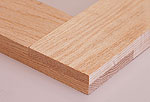 Half Lap Joint – A simple but very strong joint made by removing half the thickness from each of two parts so that one lays over the other with their surface flush with each other. The width of the material to be removed is sized to match the width of the piece it accepts to create a gapless surface. Typically used at a 90-degree corner the Half Lap Joints are occasionally used in other situations such as end-to-end and angled joints.
Half Lap Joint – A simple but very strong joint made by removing half the thickness from each of two parts so that one lays over the other with their surface flush with each other. The width of the material to be removed is sized to match the width of the piece it accepts to create a gapless surface. Typically used at a 90-degree corner the Half Lap Joints are occasionally used in other situations such as end-to-end and angled joints.
Hook Angle – The angle of the teeth in relation to the center of the arbor hole in round saw blades. The angle varies between 5-degrees and 25-degrees with the larger, more aggressive angles found on ripping blades and other designs made for relatively fast cutting. As the number of teeth increases, the Hook Angle is generally reduced to help promote ultra clean cuts.
Hot-Melt Glue – Much like the hot glue guns used in crafts, new versions are available that dispense various forms of polyurethane and other types of glue common to woodworking. Primary uses are for tacking a piece in place while other more traditional adhesive dries or mechanical fasteners are installed. Small, un-stressed pieces such as moldings and decorative appliqués are frequently installed permanently with Hot-Melt Glues. See a review of the Titebond family of glues, including their Hot-Melt Glue kit.
K
Kickback – Describes a piece of wood being thrown out of a table saw or router table. This dangerous event is nearly always caused by the operator doing something wrong, removing standard safety devices such as the splitter, or both. A fence that is tailed towards the back of the blade also increases the probability of having a kickback. See a story on a Kickback I had a few years ago.
Kerf – The width of material removed by a saw blade. Standard table saw blades remove about 1/8" of wood while Thin Kerf models cut about 3/32" of wood away. In addition to reducing the amount of wood lost to the cut, thin kerf blades require less power to drive them. This is one reason think kerf blades are often found on benchtop table saws and some miter saws.
L
 Long Grain – (Also see Short Grain) Describes the grain structure along the face and long edges of apiece of wood. Called Long grain because they run from one end of a board to the other, adhesives can grip around the fibers, creating a very strong joint. Long grain to long grain gluing situations are always preferred.
Long Grain – (Also see Short Grain) Describes the grain structure along the face and long edges of apiece of wood. Called Long grain because they run from one end of a board to the other, adhesives can grip around the fibers, creating a very strong joint. Long grain to long grain gluing situations are always preferred.
M
MDF – Medium Density Fiberboard - This is a manufactured wood product that is made by combining fine sawdust and resins (adhesives) under pressure to produce sheets that are sold in many of the same sizes as plywood. This material can be purchased plain but is frequently used as the base for laminate-covered materials.
MDO – Medium Density Overlay – This is essentially plywood with a paper (Kraft paper usually) covering on one or both flat faces. The paper covering provides a flat surface that takes paint very well. MDO is used extensively in the sign making industry for that reason. Available in common plywood sheet sizes, MDO can be difficult to find in some areas. Asking the local sign painter is often the best way to track down a supplier.
Measuring Diagonals – Used to check box-type projects, square or rectangular, like cabinets or boxes for square. The dimension measured from the top right corner to the lower left corner should be identical to that measured from the top left corner to the lower right corner. If they do not match, placing a clamp across the longest one and squeezing it a bit over one half of the difference before allowing the glue to dry will usually produce a very square cabinet.
O
Open Time – Also called "set" or "working" time, this is the period between applying an adhesive and when it begins to harden, or set up. While fast setup is often desirable to speed building, longer open times can be handy with complicated assemblies like dovetails or having to align several pieces.
OSB – Oriented Strand Board – (Also called chip or flake board) This material is made by combining chips or flakes of wood, the fibers roughly aligned in opposing layers, with adhesives to produce sheet stock. OSB is frequently used as sheathing in home building and has limited usefulness in woodworking for back panels or projects with low appearance demands.
P
Palm-Grip Sander – Also called a ¼-sheet sander because it uses ¼ of a standard sheet of sandpaper. Most commonly used for finish sanding, the palm-grip sander remains popular with serious woodworkers, most of whom also use a random orbital sander (ROS) first. (See a review of a palm-grip sander for more details)
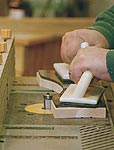 Push Block – A flat, rubber-bottomed pad with an elevated handle, used to push stock across a machine. Usually supplied with jointers, Push Blocks can be very useful at the table saw and router table also. Push Blocks are particularly useful when working with sheet stock or wide boards.
Push Block – A flat, rubber-bottomed pad with an elevated handle, used to push stock across a machine. Usually supplied with jointers, Push Blocks can be very useful at the table saw and router table also. Push Blocks are particularly useful when working with sheet stock or wide boards.
I use push blocks even when the wood is large enough to manipulate by hand. The rubber pushblock sole gives a very good grip, plus the added margin of safety is comforting.
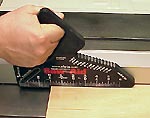 Push Handle – A long, flat piece of wood (shop-made) or composite (commercially made) with an elevated handle included in the shape and a "heel" or step near the rear that hooks over the wood. The extended length contacts more wood and makes it easier to maintain directional control over the wood as it is pushed across the cutter. Used most often at the table saw, the Push Handle can also be useful on the router table.
Push Handle – A long, flat piece of wood (shop-made) or composite (commercially made) with an elevated handle included in the shape and a "heel" or step near the rear that hooks over the wood. The extended length contacts more wood and makes it easier to maintain directional control over the wood as it is pushed across the cutter. Used most often at the table saw, the Push Handle can also be useful on the router table.
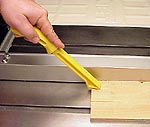 Push Stick – A simple straight piece of wood or plastic and a notch on one end that fits over the edge of the wood being cut and some type of formed handle at the operators end. Push Sticks are often supplied with table saws but their design makes them much less effective at controlling the wood being cut than Push Handles or Push Blocks.
Push Stick – A simple straight piece of wood or plastic and a notch on one end that fits over the edge of the wood being cut and some type of formed handle at the operators end. Push Sticks are often supplied with table saws but their design makes them much less effective at controlling the wood being cut than Push Handles or Push Blocks.
R
 Rabbet – One of the basic forms of joinery, a rabbet is simply a step or ledge cut into the edge of a piece of wood. Rabbets are commonly used to sink back panels of cabinets into the sides to conceal the back panel edge grain. Rabbets can also be used for corner joinery though this is a relatively weak joint. Tools used to cut rabbets include flat-bottomed router bits, specialized rabbeting router bits and stacked dado blades. Many floor model jointers have a special edge that is used to cut rabbets.
Rabbet – One of the basic forms of joinery, a rabbet is simply a step or ledge cut into the edge of a piece of wood. Rabbets are commonly used to sink back panels of cabinets into the sides to conceal the back panel edge grain. Rabbets can also be used for corner joinery though this is a relatively weak joint. Tools used to cut rabbets include flat-bottomed router bits, specialized rabbeting router bits and stacked dado blades. Many floor model jointers have a special edge that is used to cut rabbets.
Rails – Most often used to describe the horizontal pieces of a door frame, the term can also be applied to horizontal parts of face frames and similar structures. Rails on doors always run between the vertical Stiles that extend fully from top to bottom of the door. The Rails are usually wider than the Stiles by 10 to 30-percent to enhance the visual appeal of the door.
ROS, Random Orbital Sander – The most commonly used sander in woodworking, a spinning disk that also moves through an irregular orbit, drastically reduces the amount of scratching older sanders with one motion produced. (See a review of an ROS with more details)
Reading the Grain – Determining the direction and angle at which the grain in wood runs. Whenever possible, cutting or machining should go with or "down" the grain. If we work against, or "up" the grain, the edges of the grain can lift, causing a rough surface or even a failure of the wood. (See Reading Grain Direction in the Tips & Tricks section)
Relief Angle – The downward bevel on the back of cutting teeth that prevents them from dragging on the bottom of the cut as they swing through an arc.
S
Shear – A joint or fastener is said to be in Shear when forces being applied try to push through it rather than applying twisting or torquing forces. The end of a shelf, captured in a dado is in Shear when the weight of the books pushes down on it. Typically, a joint or fastener can withstand considerably more Shear forces than leveraged force such as twisting or torquing.
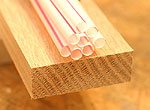 Short Grain – (Also see Long Grain) Also called end grain, this is the end of the wood fibers that make up the grain structure at the end of a board. Trying to glue or cut the ends of the wood grain can be very difficult. When Short Grain is part of a joint, (short grain to short grain or short grain to long grain) the ends of the wood fibers afford glue very little to grip. Also, cutting across the Short Grain tends to fray or separate the ends of the fibers.
Short Grain – (Also see Long Grain) Also called end grain, this is the end of the wood fibers that make up the grain structure at the end of a board. Trying to glue or cut the ends of the wood grain can be very difficult. When Short Grain is part of a joint, (short grain to short grain or short grain to long grain) the ends of the wood fibers afford glue very little to grip. Also, cutting across the Short Grain tends to fray or separate the ends of the fibers.
Sliding Dovetail Joint – Made by cutting a dovetail-shaped groove in one piece and a matching dovetail shape in the edge of another board, sized so the edge slides into the groove with minimal play. This joint is used in all types of cabinetry including for separating panels, face frame dividers and virtually any place a very strong joint is needed.
Splitter – A simple device, usually flat steel, that prevents the saw kerf, or path cut by the blade, from closing on the back of the blade as tension within a piece of wood is released during a cut. Splitters are an integral part of most blade guard/anti-kickback assemblies on table saws. The Splitter also helps prevent the wood from turning into the blade as it passes the back edge. This rotation into the blade is a primary (though not the only) cause for Kickbacks.
Stiles – Most often associated with the vertical parts of a door frame, Stiles can also be the vertical parts of face frames and similar structures. Stiles always run the full height of a door with the Rails captured between them. Typically, Stiles are 10 to 30-percent narrower than the Rails.
Have a comment or word suggestion? - Email Me!
All written, photographic and drawn materials are property of and copyright by NewWoodworker.com LLC 2000-2019. Materials may not be used in any way without the written permission of the owner.

